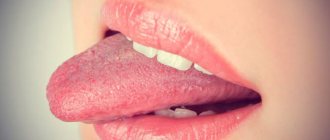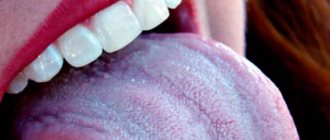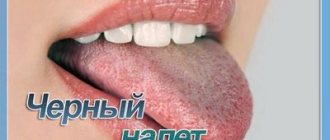What kind of coating on the tongue indicates health problems?
If there is a thickening of the plaque, a change in its color and the appearance of an unpleasant odor from the mouth , this is already the result of the activity of bacteria and fungi. Of course, the body is not a sterile substance and microorganisms are always present in it, but the immunity of a healthy child controls their numbers. When immunity decreases or any disease occurs, there is a significant increase in pathogenic bacteria and fungi, which is accompanied by the formation of plaque on the child’s tongue.
Causes of plaque on the tongue
There are many reasons why various plaques may appear on the tongue: from the banal consumption of foods that can change the color of the tongue, to serious health problems that require immediate medical attention.
Read also: Computer anesthesia STA – dentistry WITHOUT PAIN!
The very first thing you need to do when you discover strange coatings on a child’s tongue is to remember what the baby ate in the last 24 hours. Very often, sweet carbonated drinks, caramels or other sweets contain active dyes that can give the oral mucosa the most exotic shades: crimson, purple, green, orange and others. Even natural berries and fruits can radically change the color of the tongue. Therefore, there is no need to panic right away. You should ask the child to brush his teeth and tongue, and then evaluate their condition and color. If the plaque has not changed or has reappeared without connection with food intake, then this is a reason to urgently visit your pediatrician.
White coating on the tongue
White plaque can be found in the oral cavity of a baby most often.
This phenomenon also happens normally when, after a night’s sleep, a thin white coating without an unpleasant odor is found on the tongue, disappearing after hygiene procedures and not causing any discomfort or unpleasant sensations.
The appearance of a dense whitish plaque, which is extremely difficult to remove from the surface of the tongue and does not disappear after brushing your teeth, may indicate problems with the gastrointestinal tract (gastritis, enteritis or dysbacteriosis). This phenomenon is often accompanied by bad breath. In addition, children may present complaints that may indicate gastrointestinal pathology:
- abdominal pain of various localizations;
- bloating;
- stool disorders;
- change in appetite
In order to get rid of such white plaque, it is necessary, first of all, to examine the digestive system and eliminate even the most minor disturbances in its functioning.
Read also: Drilling teeth? NO thanks, we use ICON!
In infants up to 2 months of life, thrush or oral candidiasis is a common occurrence in a nursing mother, especially after taking antibiotics or an error in diet. With this pathology, abundant cheesy white deposits appear on the tongue and cheeks, which are easily removed, and small ulcers are found underneath them. After starting treatment for thrush with antifungal agents and treating the oral cavity with antiseptic solutions, the tongue and other mucous membranes quickly cleanse and regain their previous appearance.
Main types of raid
Before you figure out why your tongue is orange, you need to know exactly what types of plaque there are.
Localization differs as follows:
- completely covers the tongue;
- localized at the edges;
- located at the root;
- concentrated in the center;
- accumulates at the tip;
- located under the tongue;
- has one-sided localization.
The type of plaque can be thick, dry, or greasy. Depending on the time of occurrence, such a disorder can be present constantly, it can only occur in the evening, in the morning, it occurs after coloring products or taking certain medications.
By the nature of the plaque, one can accurately judge the presence of certain diseases. In order not to trigger the development of a dangerous pathology, it is imperative to accurately assess the general condition of the surface of the tongue every morning before brushing your teeth.
Gray coating on the tongue
A gray coating on the tongue can be a sign of some infectious diseases.
For example, with scarlet fever, on the very first day the mucous membranes become covered with a dirty gray coating, which, starting from the tip of the tongue, gradually disappears and reveals a “raspberry tongue” - enlarged papillae on a bright red background, which is very reminiscent of raspberries.
With diphtheria, gray filmy deposits can be found on the root of the tongue, which are difficult to separate. Such plaques spread to the mucous membranes of the throat, palatine arches and are accompanied by coughing and attacks of suffocation.
Treatment of such infectious diseases is carried out only in a hospital setting. After healing, all plaque on the tongue disappears.
Dehydration in a child can also lead to the formation of a gray coating on the surface of the tongue. At the same time, the mucous membranes look dry and dull. Replenishing the required volume of fluid quickly eliminates this symptom.
Bald
Normally, the lingual surface is covered with a large number of small taste buds, which give it a velvety appearance. If such papillae die or atrophy for any reason, “bald” spots appear. They are pink in color, irregular in shape and do not spread to the mucous membranes of the cheeks, lips or gums.
Reasons that can cause the appearance of such pink “bald” spots:
- Inflammatory diseases (glossitis, stomatitis).
- Tongue injuries.
- Burns from heat or chemicals.
“Bald” spots do not cause any inconvenience to children, but may slightly change the taste sensations. It is impossible to cure such formations, since the taste buds cannot be restored.
If you find that your one-year-old or older child’s tongue has become spotted, you should not panic and try to treat it yourself. Also, the appearance of spots on the tongue should not be ignored, as they may indicate the presence of serious diseases. It is necessary to consult a doctor who will find out the exact cause of such changes and, if necessary, select appropriate treatment for the child.
Yellow coating on the tongue
A dense yellow coating on the tongue indicates pathology of the liver or biliary tract.
Often in children, diseases of the biliary system occur without a clear clinical picture, and the presence of bile stagnation can only be suspected by a change in the color of deposits on the mucous membranes of the oral cavity.
If a child has a yellow coating on the tongue , it is necessary to urgently consult a doctor and have an examination of the internal organs and the biochemical composition of the blood.
Read also: Medication sleep - WHAT? For what? HOW?
Diagnostics
If a child has noticed a change in the color of the mucous membrane on the tongue, it is necessary to first exclude everyday incidents that led to this effect.
If a child has noticed a change in the color of the mucous membrane on the tongue, it is necessary to first exclude everyday incidents that led to such an effect.
It is impossible to eliminate dangerous situations on your own, so it is recommended to contact your local pediatrician.
After the examination, you may need to consult a dentist or gastroenterologist.
If severe somatic pathologies are detected, the child is referred to a specialized specialist (endocrinologist, hepatologist, nephrologist, hematologist).
To confirm or refute a preliminary diagnosis, it is necessary to conduct a number of studies:
- blood, stool and urine tests;
- a detailed biochemical blood test (for the level of glucose, bilirubin, ALT, AST, creatinine, urea, etc.);
- Ultrasound of organs involved in the functioning of the digestive system, and, if necessary, the abdominal cavity;
- esophagogastroduodenoscopy.
Vegetables and fruits that are yellow can cause your tongue to turn yellow.
Green coating on the tongue
The appearance of a green coating on the mucous membrane of the tongue often frightens parents, especially if it is found in a newborn or infant.
The most common cause of this phenomenon is candidiasis - a fungal infection of the oral cavity that occurs due to imperfect immune defense in the body of a 1-year-old baby or while taking strong antibacterial drugs.
This plaque has varying color intensities and can spread to other parts of the oral cavity, found on the cheeks, palate and lips. After removing it, you can see the red surface of the tongue with small blisters or ulcers, which cause discomfort to the child.
You should start treating green plaque only after consulting a doctor. Therapeutic measures will consist of taking special drugs with antifungal action and local antiseptics to treat thrush and prevent bacterial complications.
Read also: How bite affects posture and spinal health
What symptoms should parents be wary of?
Regurgitation may be a sign of a disease, and in this case, you cannot do without the help of a doctor. The child must be shown to a pediatric neurologist if he:
- regurgitates profusely (“gushing”), the intensity of regurgitation is 3 or more points;
- when regurgitating, he becomes capricious and cries;
- after regurgitation, he demands to be fed again, as he remains hungry;
- does not gain enough weight, sleeps poorly;
- has symptoms of respiratory diseases, suffered from pneumonia (especially in the first 6 months of life).
The presence of serious pathologies may be indicated by:
- a sharp decrease in body weight;
- decreased frequency of urination (less than 8-10 times during the day);
- profuse vomiting of the stomach with an admixture of bile;
- lack of stool.
Regurgitation may indicate some problems in the body if they do not stop in a one-year-old baby.
Brown coating on the tongue
A brown tongue in a child is not such a rare occurrence. There can be many reasons for this:
- Severe diseases of the digestive system , accompanied by inflammatory changes, stagnation of bile in the bile ducts, and disruption of the digestive processes.
- Constant dehydration of the child's body due to high ambient temperatures or insufficient fluid intake.
- Insufficient intake of B
- Taking certain medications : antibiotics, antiseptic solutions, concentrated herbal decoctions.
It is very difficult to establish the exact root cause of the appearance of such a dark plaque. This can only be done by an experienced doctor, who, after additional examinations, will be able to prescribe the optimal treatment.
Treatment
There is no need to treat yellow plaque without eliminating the causes that caused this effect. Therefore, after examination by a doctor (or several specialists), the patient is prescribed medication.
Since most of the causes are associated with disruption of the digestive system, in particular the correct outflow of bile, a series of studies are prescribed, based on the results of which treatment tactics are developed.
Therapeutic therapy is carried out in inpatient and outpatient settings. This issue can only be resolved by a specialist. In addition to medications, a dietary diet is recommended, including lean protein and vegetable foods.
Therapy is often enhanced with phototherapy, sanatorium treatment, and folk methods involving the use of decoctions based on medicinal herbs.
The following components are considered the most effective:
- bee products (propolis, honey);
- a decoction of sage and chamomile for rinsing the mouth;
- eating coarsely chopped vegetables (hard structure removes plaque).
Black coating on the tongue
The presence of a black coating on a child’s tongue looks quite scary, and there may be several reasons for this phenomenon:
Bacterial sore throat is often accompanied by the appearance of dark plaques on the mucous membranes, even black. In this case, the child will have signs of inflammation in the tonsils: red throat, high fever, pain when swallowing, weakness.
Hidden forms of diabetes mellitus, which lead to persistent disruption of the acid-base balance in the body. Excess acid or acidosis will cause darkening of the tongue.
Taking some antibiotics causes the growth of pathogenic microflora in the mouth, which causes the mucous membranes to become permanently stained black.
Treatment of such plaque will consist of eliminating the causes that caused its appearance. After a sore throat is treated, medications are stopped, or diabetes is identified and compensated for, this symptom will most likely go away on its own.
Dark
Dark spots on the tongue often occur when eating food that contains dark pigments that color the plaque on the surface of the mucous membranes. Such spots do not pose any danger to the child and disappear after hygiene procedures. But there are a number of conditions that manifest as dark spots in the mouth and which can have very serious consequences.
Black
Black spots on the tongue in children most often appear during a long course of antibiotic therapy as a result of the active proliferation of microorganisms and fungi. Blackening of the tongue develops gradually and can last up to 2-3 weeks. The main treatment for this condition is to restore normal microflora in the child’s intestines and oral cavity. For this purpose, eubiotic drugs are prescribed (for example, Linex, Bifidumbacterin, Lactobacterin).
It is extremely rare that black spots on the tongue appear as a result of deep degenerative processes accompanied by necrosis of areas of the mucous membrane. This condition is very dangerous and requires emergency medical attention. The treatment of such spots is often surgical.
Blue
Blue spots in a child's mouth are a rare occurrence. They may appear in the following situations:
- The presence of severe heart failure due to heart disease and defects. Spots on the tongue appear due to stagnation of blood in the venous bed and are accompanied by blue discoloration of the lips and limbs. Their treatment consists of eliminating cardiac pathology and normalizing blood microcirculation in the vessels.
- With the growth of a benign vascular tumor - hemangiomas. This blue spot is most often single. Treatment is only possible through surgery.
Blue coating on the tongue
A blue tongue is a sign of blood stagnation.
Very often, various diseases of the cardiovascular (congenital heart defects, arrhythmias, heart failure) and nervous system (hemorrhages, cysts, epilepsy) lead to the fact that blood flows through the tissues more slowly than it should - cyanosis or cyanosis appears on the limbs, lips and language. Therefore, if you notice such a symptom in your child, you should urgently contact your doctor for advice.
Read also: Now the beauty and health of your child is completely in your hands
Prevention
In order to prevent the appearance of plaque on a child’s tongue, there are a number of preventive measures that many experts focus on:
- The room in which the child lives should always be clean, well ventilated and humidified.
- You should not prescribe antibiotics to your child yourself. The use of such medications must be strictly justified.
- It is necessary to closely monitor the baby's health. If the slightest symptoms appear that indicate a possible disease from the internal organs, you should urgently seek medical help.
- Limit your child's consumption of sweets containing synthetic coloring pigments: sweet carbonated drinks, candies, chewing gum. This will not only prevent the appearance of active staining of the tongue, but will also preserve the health of delicate children's teeth.
If plaque does appear on the tongue, there is no need to try to remove or treat it yourself. Consult your doctor about the possible causes of this phenomenon and the necessary treatment for it.
Posted in For parents by biglamed










